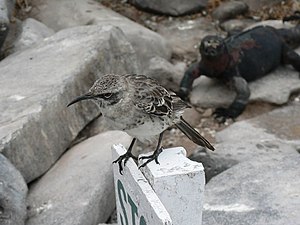Española mockingbird
| Española mockingbird | ||||||||||||
|---|---|---|---|---|---|---|---|---|---|---|---|---|

Española mockingbird |
||||||||||||
| Systematics | ||||||||||||
|
||||||||||||
| Scientific name | ||||||||||||
| Mimus macdonaldi | ||||||||||||
| ( Ridgway , 1890) |
The Españolaspottdrossel or Hoodspottdrossel ( Mimus macdonaldi , Syn . : Nesomimus macdonaldi ) is a kind of the mockingbirds (genus) ( Mimus ) in the family of the mockingbirds (Mimidae). It is endemic to the Galápagos island of Española and the small island of Gardner in front of it.
description
The Hood mockingbird reaches a body length of about 28 centimeters. Your back is gray-brown in color, the belly whitish-gray with only an indistinct band running across the chest. The yellowish eye is surrounded by a dark spot. The tail is long, dark and tiered, so the tail feathers decrease in length from the inside out. The beak is long and curved.
Way of life
Española mockingbirds inhabit shrubby lowlands and deciduous forests. They are omnivores that look for food in groups of up to 40 animals and feed primarily on carrion and the eggs of seabirds. It is incubated in groups of an average of nine animals in March and April. The couples are not monogamous, usually only one egg is laid.
Danger
The species is on the Red List of the IUCN out as "vulnerable" (endangered). The population size is estimated at around 1000 to 2500 animals. The main threat lies in the very small area of distribution, so that climate fluctuations or the introduction of predators could have a strong impact on the total population.
swell
- The Española Mockingbird at Birdlife
- Mimus macdonaldi in the endangered Red List species the IUCN 2011. Posted by: BirdLife International, 2008. Accessed November 13, 2011th
